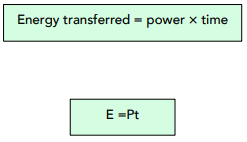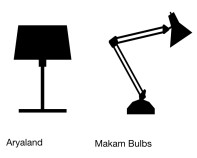Power: Work Done (GCSE Physics)
Power: Work Done
Work Done
Work is done when charge flows in a circuit.
As with any form of ‘work’, energy is transferred when electrical work is done. We will calculate the energy transferred by electrical work in the next tutorial.
We can calculate energy transferred in one of two ways.
Using Power and Time
Power tells us the energy transferred per second. To find the total energy transferred over a sustained period of time, we need to multiply power by the total number of seconds.

Where:
- energy transferred, E, in joules, J
- power, P, in watts, W
- time, t, in seconds, s
Question: An electric lamp transforms 400 J in 8 s. What is its power?
1. Write out the equation.
In this instance, we need to rearrange the equation to make power the subject.
E = Pt
P = E / t
2. Substitute in the numbers.
P = 400 / 8
P = 50 Watts
Question: A motor has a power of 12W. How much energy does the motor transfer in 1 minute?
E = P t = 12 x 60 = 720J
Question: Ankit is deciding between purchasing a lamp from Aryaland and a lamp from Makam Bulbs. The lamp from Aryaland has a power of 6W, whilst the lamp from Makam Bulbs has a power of 10W.
Assuming 100% efficiency in both lamps, what is the difference in the kilojoules (kJ) of energy produced in 2 hours?

The difference between the powers: 10W – 6W = 4W
We need the answer in seconds, hence 2 hours = 120 minutes x 60
seconds = 7200 seconds
E = P x T = 4 x 7200 = 28800
To convert to kilojoules: 28800/1000 = 28.8
Using Charge and Voltage
We can also calculate energy transferring using charge and potential difference. Let us look at the first equation, E = Pt.
We can substitute in P = VI into the equation E = Pt, to give E = VIt.
Current is just the rate of charge flow, I = Q/t. We can substitute in I = Q/t into E = VIt, to give E = V x Q/t x t. This simplifies to E = VQ.

Where:
- energy transferred, E, in joules, J
- charge flow, Q, in coulombs, C
- potential difference, V, in volts, V
Question: A motor has a power of 12W. How much energy does the motor transfer in 1 minute?
1. Write out the equation.
E = QV
2. Convert into seconds.
In the question, we have been given a time in minutes, therefore we need to convert into seconds.
1 minute = 60 seconds
3. Substitute in the numbers.
We need to use the value for time in seconds (which we have just calculated).
E = 12 x 60
E = 720 J
Power Ratings and Energy
- The power rating is a maximum value. When a customer buys an electrical device, it comes with a power rating. This is the maximum value at which the appliance can be used safely. We also know that power is the rate of energy transfer. Therefore, the power rating also tells us the maximum rate at which energy can be transferred when using the appliance.
- Power ratings can vary. Some power ratings are low, whilst others are high. We know that electrical device can store energy. A high power device will be transfer more of this energy per second, therefore doing more work. By doing so, a high power device will require more electricity.





Still got a question? Leave a comment
Leave a comment